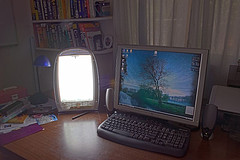The Polymerase Chain Reaction (PCR) Can Make Millions of Copies of DNA in a Short Time
The polymerase chain reaction (PCR) is a rapid way of amplifying (duplicating) specific DNA sequences
Method was devised by Kary Mullis of Cetus Corporation, Emeryville
He recieved a $20,000 bonus and later a Nobel Prize
Later the patent was sold to Hoffman-LaRoche for $300,000,000
DNA heated to high temperature is not destroyed; separates into single strands, but reforms helix when cooled
PCR Method:
DNA to be amplified is put into solution containing:
Short DNA “primers” which can bind to the 3′ ends of the DNA
This is a preview of BIOTECHNOLOGY AND BIOMEDICAL TUTORIAL-PCR, RFLP Analysis & Gene Therapy.
Read the full post (1630 words, 10 images, estimated 6:31 mins reading time)
The Respiratory System is Designed to Bring in Oxygen and Remove Carbon Dioxide
A person with an average ventilation rate of 7.5 L/min will breathe in and out 10,800 liters of gas each day
From this gas the person will take in about 420 liters of oxygen (19 moles/day) and will give out about 340 liters of carbon dioxide (15 moles/day)
The ratio of CO2 expired/O2 inspired is called the respiratory quotient (RQ)
RQ = CO2 out/O2 in = 340/420 = 0.81
In cellular respiration of glucose CO2 out = O2 in; RQ = 1
BASIC CLINICAL SCIENCES , HUMAN ANATOMY & PHYSIOLOGY , TUTORIALS Add new tag , Breathing , Lung volumes , Pleural cavity , Respiratory System , Thoracic cavity , United States , Ventilation , Vital capacity
Phototherapy
Definition
Phototherapy, or light therapy , is the administration of doses of bright light in order to normalize the body ‘s internal clock and/or relieve depression.
DESCRIPTION
Phototherapy is generally administered at home. The most commonly used phototherapy equipment is a portable lighting device known as a light box. The box may be mounted upright to a wall, or slanted downwards towards a table. The patient sits in front of the box for a prescribed period of time (anywhere from 15 minutes to several hours).
Both Light and Sound Have Oscillating Waves
Velocity Travels Through Vacuum? Wavelength Frequency
Light 186,000 miles/sec
Yes
400-700 nm
4 X 10^14
Sound About 700 mph
No
.02 to 20 meters
20-20,000 cycles/sec
Sound and light are waves in which the amplitude oscillates with time
For pure tones or colors the oscillation is a sine wave with a fixed wavelength and frequency
The wavelength is the distance between 2 peaks of the wave
Image via Wikipedia
WHAT IS TONOMETER?
THIS PARAGRAPH HAS BEEN WRITTEN IN REFERENCE TO MDU ROHTAK EXAM PATTERN
In order to ensure a person’s optic nerves are healthy, optometrists check the pressure placed on them by the fluid in the eyes. This pressure is called intraocular pressure and should measure between 10 mmHg and 21 mmHg. Measurements that are higher than normal can be a sign of early glaucoma or retinal detachment .
BASIC CLINICAL SCIENCES Add new tag , Cornea , Glaucoma , Health , Intraocular pressure , Medical Specialties , Medicine , Ophthalmology , Optic nerve , Optometry , Retinal detachment
Sound is Produced by Vibrations in Matter (Air, Liquids, Solids)
Anything which causes matter to vibrate will produce sound
Vocal cords vibrate and push on the air flowing through the larynx, causing the air to vibrate
Sound cannot travel through a vacuum
Sound velocities:
Air: 344 meters/sec (770 miles/hr)
Water: 1500 meters/sec (3360 miles/hr)
Solids: about 5000 meters/sec (11,200 miles/hr)
Pitch is Determined by the Frequency of Vibration
We perceive fast vibrations as high pitches, slow vibrations as low pitches
When we are young we can hear vibrations from about 20 hertz to about 20,000 hertz
This is a preview of SHORT NOTES ON BASIC CLINICAL SCIENCES–EAR AND HEARING MECHANISM-.
Read the full post (852 words, 4 images, estimated 3:24 mins reading time)


